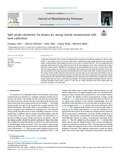JavaScript is disabled for your browser. Some features of this site may not work without it.
| dc.contributor.author | Chen, Guangyu | |
| dc.contributor.author | Williams, Stewart | |
| dc.contributor.author | Ding, Jialuo | |
| dc.contributor.author | Wang, Yipeng | |
| dc.contributor.author | Suder, Wojciech | |
| dc.date.accessioned | 2022-04-20T08:42:09Z | |
| dc.date.available | 2022-04-20T08:42:09Z | |
| dc.date.issued | 2022-04-16 | |
| dc.identifier.citation | Chen G, Williams S, Ding J, et al., (2022) Split anode calorimetry for plasma arc energy density measurement with laser calibration, Journal of Manufacturing Processes, Volume 78, June 2022, pp. 71-81 | en_UK |
| dc.identifier.issn | 1526-6125 | |
| dc.identifier.uri | https://doi.org/10.1016/j.jmapro.2022.04.003 | |
| dc.identifier.uri | https://dspace.lib.cranfield.ac.uk/handle/1826/17785 | |
| dc.description.abstract | A split anode calorimeter (SAC) has been developed for the measurement of plasma transferred arc (PTA) energy density. A novel aspect is the use of a laser beam with a well-defined energy profile which was first measured using a commercial laser beam diagnosis system and was used to calibrate the SAC. The SAC temperature data generated profile showed the same profile measured by the laser diagnosis system. This confirmed the accuracy of the SAC method and its suitability for measuring the energy distribution of an electric arc if provided stably. The PTA energy profile was observed to be distorting when crossing over the split anode interface of the SAC. This was corrected by moving the ground wire from the side to the centre of the anode. Detailed analysis of 130A PTA energy density profiles generated from both the current density and the temperature distribution of the arc showed that the current data generated profile is narrower than that of the temperature data generated profile. This indicates that the effective energy distribution is wider than that of the width of the arc column due to other energy transfer processes such as convection and radiation. The energy absorption distribution matched well to a Gaussian distribution model with a radius of 7 mm. The arc energy absorption rate of the copper plate was measured and found to be about 56%. | en_UK |
| dc.description.sponsorship | Engineering and Physical Sciences Research Council (EPSRC): EP/R027218/1 | en_UK |
| dc.language.iso | en | en_UK |
| dc.publisher | Elsevier | en_UK |
| dc.rights | Attribution 4.0 International | * |
| dc.rights.uri | http://creativecommons.org/licenses/by/4.0/ | * |
| dc.subject | Arc profile | en_UK |
| dc.subject | Split anode calorimetry | en_UK |
| dc.subject | Plasma arc | en_UK |
| dc.subject | Welding | en_UK |
| dc.title | Split anode calorimetry for plasma arc energy density measurement with laser calibration | en_UK |
| dc.type | Article | en_UK |
Files in this item
The following license files are associated with this item:
This item appears in the following Collection(s)
-
Staff publications (SATM) [4471]

